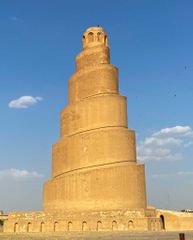![]()
![]()
![]()
Use LEFT and RIGHT arrow keys to navigate between flashcards;
Use UP and DOWN arrow keys to flip the card;
H to show hint;
A reads text to speech;
17 Cards in this Set
- Front
- Back

|
Dome of the Rock Jerusalem, Palestine Umayyad Period, 691-92 Umayyad patronage (they had a say in the design of the building) No Qur'anic mandate about the design Green and gold coloring Purple marble and glass mosaics have gold behind it, showing power and authority Site of Abrahamic faith Building creates an isle around the rock, showing it's importance No human or animal figures in decorations Decorations are pulling from traditions, made more abstract The rich range of colors are shared among Mediterranean traditions/communities Site of congregational prayer |
|

|
Great Mosque of Damascus Damascus, Syria Umayyad Period, 715 Each minaret added at different times (9th, 13th, and 15th centuries) Large, used for more than prayer Shrine of St. John the Baptist inside, shared space of Muslims and Christians Qibla wall aligns with Mecca |
|

|
Khirbat al-Mafjar (Hisham's Palace) Jericho (West Bank), Palestine Umayyad Period, 724-44, destroyed by earthquake in 747 Likely built by Caliph Hisham bin Abd al-Malik (began in 724) and decorated be heir al-Walid II in 743-44 "Desert Palace" or winter residence Residence and bath house have Roman heritage Mudbrick with overlaying of stucco Bath house has multiple domes and mosaics on all surfaces (looks as if carpets have been laid down) Repeating geometric shapes and plant motifs Persian influence |
|

|

Great Mosque of Cordoba Cordoba, Spain Umayyad Period, 786-10th century Many people expanded it Half-church and half-mosque, when the population grew the mosque bought the church side History of this mosque parallels the Great Mosque of Damascus The palm trees look back to the ones that shaded the prophet Muhammad's house and mosque Gothic church placed in during the Spanish Inquisition and is the newest part Influenced by the Dome of the Rock, Great Mosque of Damascus, and Roman aqueducts Wanted the best artists to build mosque and Byzantine artists brought in to do the mosaics Emphasis on gold and blue |
|

|
Minaret at Samarra Samarra, Iraq Abbasid Period, 848-52 Built under Caliph al-Mutawakkil Capital city for elites, military, and administrators Built along the river and mudbrick |
|

|
Great Mosque of Qairowan Tunisia Abbasid Period, 836-62 Minaret influenced by Sumara Layout influenced by Prophets house with a courtyard, enclosed prayer hall, and unadorned exterior Roman spolia (use of old architecture/reuse) Mihrab's decorative elements are vegetable motifs and interior decorated with tiles imported from Baghdad (connection to Baghdad and placed to maximize space) |
|

|
Blue Quran Tunisia Abbasid Period, 850-90 |
|

|
Ceramic Bowl Basra, Iraq Abbasid Period, 9th Century Calligraphy, 'Happiness' in Arabic |
|

|
Textile Fragment Iran or Iraq Abbasid Period, 9th Century |
|

|
Great Mosque of Isfahan Isfahan, Iran Seljug dynasty, 800-1900 |
|

|
Maqamat Illustration Second half of 10th Century |
|
|
Caliph |
Muslim leader, regarded as the successor of Muhammad; was abolished in 1924 |
|
|
Imam |
Title of Muslim prayer leaders, leader of Shiite Islam |
|
|
Mihrab |
Prayer niche, usually concave in shape with an arched top, located in the qibla wall of a mosque and indicating the direction of Mecca |
|
|
Minbar |
A stepped pulpit from which the sermon at Friday noon prayer is given in a mosque; usually placed directly next to the mihrab on the Qibla wall |
|
|
Qibla |
The direction Muslims face to pray, which since 624 C.E. has been toward the Ka'ba |
|

|
Rabit-i Sharaf Caravanserai Seljug Iran, 1114/1154 |

